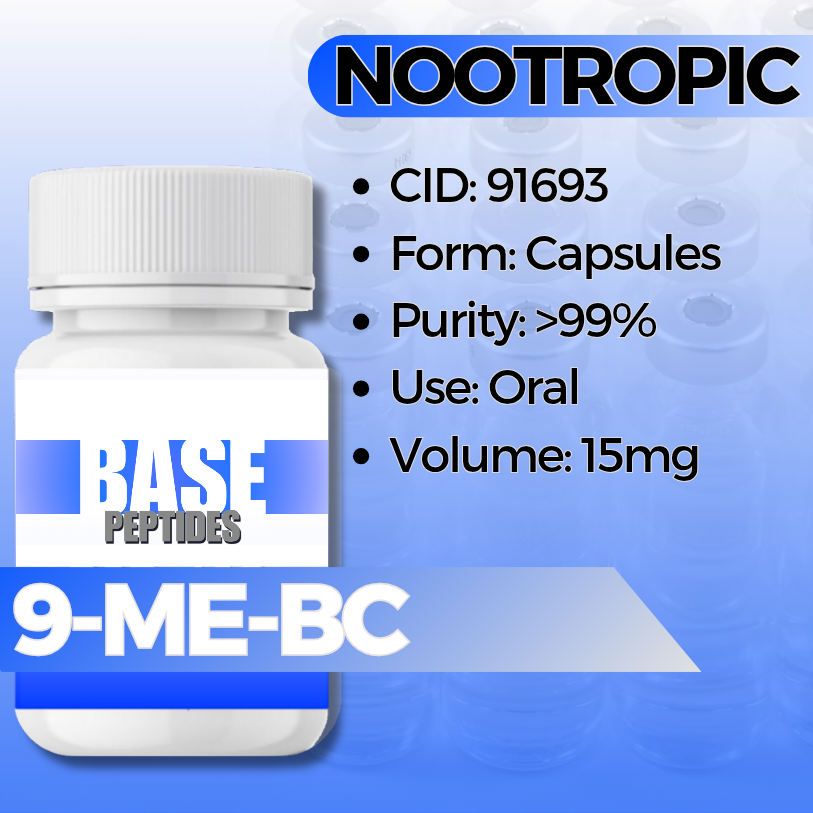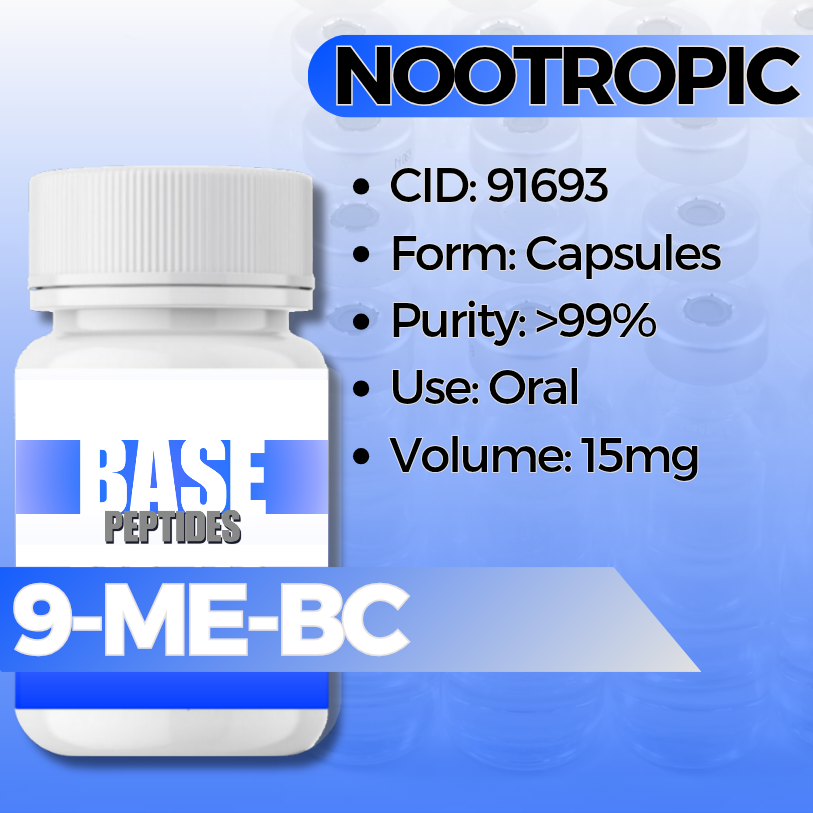9-ME-BC
9-ME-BC
Base Peptides are intended for licensed medical professionals and experienced researchers. Reconstitution required. Dosing and use instructions are not provided.
Couldn't load pickup availability
9-ME-BC — 9-Methyl-β-carboline (Dopaminergic Research Compound)
9-ME-BC is a substituted β-carboline explored in neuroscience for its effects on dopaminergic neuron biology, microglial signaling, and monoamine oxidase (MAO) activity. In preclinical settings it’s used to study neurite outgrowth, neuroinflammation, and energy metabolism pathways relevant to dopaminergic systems.
- CAS: 2521-07-5
- PubChem CID: 164979
- Formula / MW: C12H10N2 · 182.22 g/mol
- Preferred name: 9-Methyl-9H-pyrido[3,4-b]indole (9-ME-BC)
- Preclinical studies suggest 9-ME-BC can up-regulate neurotrophic genes in dopaminergic models and modulate microglial activity
- It has been shown to inhibit MAO activity in vitro, a pathway that affects dopamine metabolism (context varies by model).
- Animal work indicates support of neurite outgrowth / dopaminergic differentiation and mitochondrial-related readouts.
- To probe dopaminergic neuron maintenance and regeneration markers in vitro and in vivo.
- To examine neuroinflammatory modulation via microglia-related assays.
- To study monoamine metabolism through MAO-linked pathways and gene expression.
Key Studies — What Was Tested, What Changed, Why It Matters
Dopaminergic support & neurite outgrowth
- What was tested: Primary midbrain cultures and rodent models assessing dopaminergic differentiation, neurite growth, and behavioral readouts.
- What changed: Increased appearance of functional dopaminergic neurons in culture and restorative signals in vivo (mitochondrial and neurotrophin-related).
- Why it matters: Provides a tool to study how small heterocycles influence dopamine-system plasticity and energy handling.
Neuroinflammation & microglia
- What was tested: Glial activation markers and cytokine profiles after toxin or stress exposure.
- What changed: Reduced microglial proliferation and anti-inflammatory shifts (chemotactic cytokines down).
- Why it matters: Helps parse glia–neuron cross-talk when modeling dopaminergic injury or stress.
MAO activity & neurotrophic gene expression
- What was tested: In-vitro MAO assays and gene-expression panels in dopaminergic cell models.
- What changed: 9-ME-BC inhibited MAO activity and up-regulated genes like BDNF, ARTN, and others tied to neuron support.
- Why it matters: Links monoamine metabolism with pro-trophic signaling in a single small molecule model.
Potential Research Applications
Dopaminergic Systems
- Neurite outgrowth and synaptic markers
- Mitochondrial/respiratory chain assays
Neuroinflammation
- Microglial proliferation & cytokine profiling
- Neuron–glia co-culture models
Monoamine Metabolism
- MAO activity panels (A/B)
- Dopamine turnover and gene-expression arrays
Synergistic Research Pairings
Semax / Selank
- Why pair: Neuroplasticity and neuroimmune modulators that complement dopaminergic assays.
- Angle: Combine behavioral tasks with BDNF/cytokine panels to probe converging mechanisms.
SS-31 (Elamipretide) (if offered)
- Why pair: Mitochondria-targeted peptide for bioenergetic endpoints alongside 9-ME-BC.
- Angle: High-resolution respirometry + neurite/microglia markers.
GHK-Cu / BPC-157
- Why pair: Tissue microenvironment and repair-signaling complements for multi-pathway designs.
- Angle: ECM + neuronal markers in mixed cultures or injury paradigms.
Design Notes
- Document solvent/vehicle (β-carbolines are light-sensitive heteroaromatics).
- Include MAO controls and parallel trophic-gene assays for mechanism clarity.
- Pre-define glial vs neuronal endpoints to separate effects by cell type.
Known Concerns (Context)
- Concentration-dependent effects: β-Carbolines can show cytotoxicity at higher micromolar ranges in some cell lines; titrate and include viability controls.
- MAO interaction: Inhibition of MAO activity means monoamine levels can shift—design.
- Handling hazards: Causes skin/eye irritation per SDS; use PPE and handle in a fume hood.
Specifications & Handling
- Form: Crystalline powder (lot-coded)
- Purity: ≥ 98–99% (HPLC; supplier/lot dependent)
- Storage: Protect from light; keep tightly closed; cool, dry conditions
- In solution: Prepare fresh, light-protected aliquots; verify stability in chosen solvent
- Additives: None unless specified per lot
- Packaging: Tamper-evident; research-only labeling
Regulatory & Use Notice
Sold for laboratory research use only. Not for human consumption, medical, or veterinary use. No human-use instructions are provided. Buyer is responsible for safe handling and regulatory compliance.
9-ME-BC (9-Methyl-β-carboline) Research | Dopaminergic Neuron, MAO Activity & Microglia Modulation


